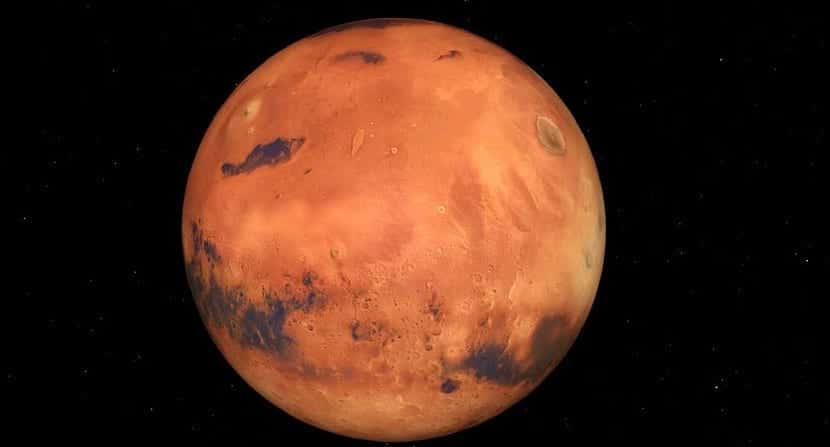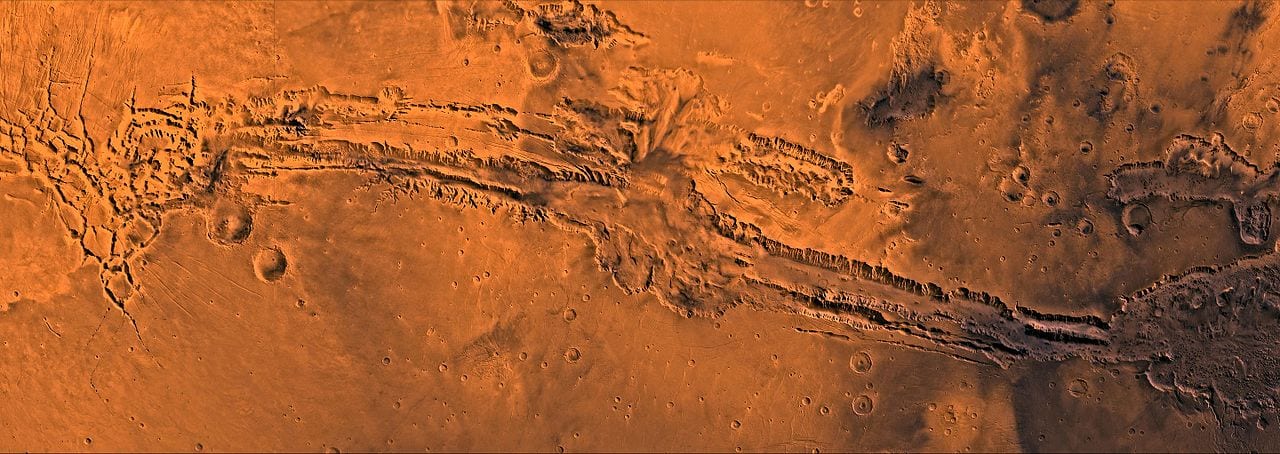
Mars is an icy world today. However, throughout history it had moments of better temperature through which rivers and seas flowed, with melted glaciers, and possibly there was life in abundance.
However, today, Mars has a parched surface in which the amount of water in its atmosphere often condenses into frost, especially near its north pole. In that area it forms perennial ice caps. What happened to the climate of Mars?
The surface and atmosphere of Mars
Although it seems unprecedented, although CO2 retains heat, in the region of the south pole of the planet Mars, Lots of frozen CO2 resides. The surface of this planet does not show signs of water, except in some frosty areas or in the form of valleys opened by old floods.
The atmosphere of Mars is cold, dry, and rarefied. This thin veil, composed mostly of CO2, creates a pressure on the surface that is less than 1% of that registered on Earth at sea level. The orbit of Mars is 50% further from the Sun than our planet. In addition, the atmosphere that surrounds it is very fine, which contributes to this icy climate. Average temperatures are -60 degrees, reaching temperatures of -123 degrees at the poles.
Quite the opposite the planet venus . The midday sun is capable of heating the surface enough to be able to produce an occasional thaw, but the low atmospheric pressure causes the water to evaporate almost instantly.

Although the atmosphere contains a small amount of water and sometimes clouds of water and ice occur, the Martian climate is characterized by sandstorms or gales of carbon dioxide. Every winter, a blizzard of icy carbon dioxide hits one of the poles, and as icy carbon dioxide evaporates on the opposite polar cap, several meters of that dry ice snow accumulate. But even in the pole where it is summer and the sun shines all day, the temperatures rise so much as to melt that icy water.
The past of Mars
Most of the craters on Mars are heavily eroded. Around almost every youngest and largest crater you can see structures similar to mud runoffs. These muddy droppings are probably frozen remnants of ancient cataclysms, collisions of asteroids or comets with the surface of Mars, which melted areas of the frozen permafrost and carved huge holes deep underground to reach areas that contained liquid water.
Evidence has been found that at some time ice formed on the surface that created typically glacial landscapes. These include rocky ridges made up of sediments left on their margins by melting glaciers, and meandering strips of sand and gravel deposited under glaciers by rivers that run under the ice sheet.

It is possible that the water cycle on Mars had components in the wet episodes. A dense atmosphere would most likely contain a considerable amount of water evaporated from lakes and seas. The water vapor would condense to form clouds and eventually fall into rain. The falling water would create runoff and much of it would seep through the surface. On the other hand, the snowfalls would have accumulated forming glaciers, and these would discharge their meltwater into glacial lakes.
Some of the images taken from Mars reveal the existence of huge drainage channels ruptured on the surface. Some of these structures are more than 200 kilometers wide and stretch for 2000 kilometers or more. The geometry of these drainage channels indicates that the water could have crossed the surface no less than at about 270 kilometers per hour.
A lost ocean?
In some high areas of Mars there are extensive systems of valleys that drain into sedimentary bottom depressions, low areas that were once flooded. But these lakes were not the largest accumulations of water on the planet. In recurrent floods, the drainage channels discharged towards the north and thus formed a series of transient lakes and seas. As can be interpreted in photos, many of the features observed around these old impact basins mark the areas where the glaciers discharged into those deep bodies of water.
According to various calculations, one of the largest seas north of Mars could have displaced a volume equivalent to that of the Gulf of Mexico and the Mediterranean Sea together. There is even the possibility that an ocean had existed on Mars. The proof of this is based on the fact that many of the features of the northern plains were reminiscent of the erosion of the coastlines. This hypothetical ocean was called the Borealis Ocean. It is estimated that it could be about four times larger than our Arctic Ocean and the model of the water cycle on Mars was proposed that could explain its creation.

Most planetology experts now accept that large bodies of water recurrently formed on the northern plains of Mars, but many deny that there ever was a true ocean.
Climate Change
On a young Mars, vigorous erosion could take place, smoothing the surface. But later, as he progressed into middle age, his face turned cold, dry, and scarred. Since then there will have only been a few scattered temperate periods that rejuvenated its surface in certain areas.
However, the mechanism that alternates between mild and severe regimes on Mars remains largely a mystery. At the moment, it is only possible to venture little elaborate explanations of how these climatic changes could have happened.
One of the hypotheses of climatic changes on Mars is based on the inclination of the axis of rotation from its ideal position, perpendicular to the orbital plane. Like the Earth, Mars is now tilted about 24 degrees. This inclination varies regularly over time. The incline also changes sharply. Every 10 million years or so, the variation of the tilt axis covers, sporadically, up to 60 degrees. Likewise, the orientation of the tilt axis and the shape of the orbit of Mars change over time, according to a cycle.

These celestial mechanisms, especially the tendency of the axis of rotation to tilt excessively, cause extreme seasonal temperatures. Even with a rarefied atmosphere like the one that covers the planet today, summer temperatures at mid- and high-latitudes could have steadily exceeded freezing for weeks during periods of high slant, and the winters would have been even harsher than they are today.
With sufficient warming of one of the poles during the summer, however, the atmosphere must have changed drastically. It is possible that the emission of gases from the overheated ice cap, from carbonic groundwater or permafrost rich in carbon dioxide, thickened the atmosphere enough to generate a transient greenhouse climate. Under these conditions there could be water on the surface. The aqueous chemical reactions would have, in turn, formed in those warm periods salts and carbonate rocks; the process would slowly remove carbon dioxide from the atmosphere and therefore reduce the greenhouse effect. A return to moderate levels of obliquity would further cool the planet and precipitate dry ice snow, further thinning the atmosphere and returning Mars to its normal icy state.